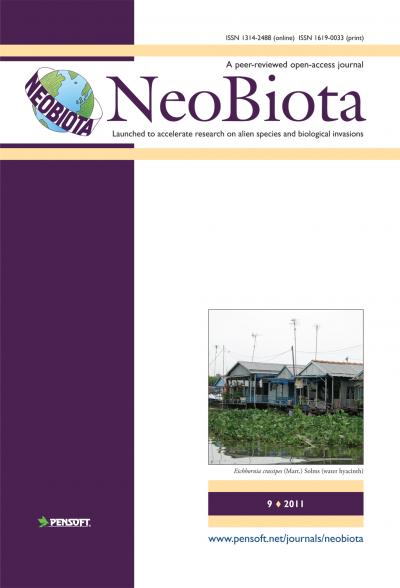A引入伊比利亚淡水和过渡水域的水生非本地物种的多分类群评估
IF 3
2区 环境科学与生态学
Q1 BIODIVERSITY CONSERVATION
引用次数: 0
摘要
水生生态系统特别容易受到非本地物种(NIS)引入的影响,在世界范围内造成多方面的生态、经济和健康影响。伊比利亚半岛是一个生物多样性异常丰富的地中海地区,拥有大量受威胁和特有的水生物种,其中大多数受到生物入侵的强烈影响。我们采用结构化的方法,结合对现有信息和专家意见的系统审查,提供了伊比利亚内陆水域水生NIS(真菌、大型藻类、维管植物、无脊椎动物和脊椎动物)的全面和更新的多分类群清单。此外,我们还评估了上市NIS的建立状况、引入途径、原生范围和时间趋势的总体格局。此外,我们还讨论了国家(西班牙和葡萄牙)和欧洲NIS法规提供的法律覆盖范围。在伊比利亚内陆水域共调查了326个水生NIS,其中215个已建立,96个不确定建立状态,15个隐生分类群。无脊椎动物(54.6%)和脊椎动物(24.5%)是NIS数量最多的类群,节肢动物、软体动物和脊索动物是最具代表性的门。有记录的NIS来自不同的地理区域,以北美和南美最为常见。脊椎动物和维管植物大多是通过有意途径(即释放和逃逸)引入的,而无脊椎动物和大型藻类大多是通过无意途径(即污染或偷渡者)进入的。大多数记录的NIS是在20世纪下半叶在伊比利亚内陆水域引进的,2000年代报告了大量的NIS引进。虽然记录在案的NIS中只有8%出现在欧盟关注的外来入侵物种名单中,但在西班牙和葡萄牙的NIS法规中列出了约25%。本研究提供了最新的伊比利亚水生NIS清单,满足欧盟法规的要求,并为评估其应用提供了基线。我们指出,需要采取协调的跨国战略,妥善解决欧盟成员国跨境水生入侵问题。本文章由计算机程序翻译,如有差异,请以英文原文为准。
A multi-taxa assessment of aquatic non-indigenous species introduced into Iberian freshwater and transitional waters
Aquatic ecosystems are particularly vulnerable to the introduction of non-indigenous species (NIS), leading to multi-faceted ecological, economic and health impacts worldwide. The Iberian Peninsula comprises an exceptionally biodiverse Mediterranean region with a high number of threatened and endemic aquatic species, most of them strongly impacted by biological invasions. Following a structured approach that combines a systematic review of available information and expert opinion, we provide a comprehensive and updated multi-taxa inventory of aquatic NIS (fungi, macroalgae, vascular plants, invertebrates and vertebrates) in Iberian inland waters. Moreover, we assess overall patterns in the establishment status, introduction pathways, native range and temporal introduction trends of listed NIS. In addition, we discuss the legal coverage provided by both national (Spanish and Portuguese) and European NIS regulations. We inventoried 326 aquatic NIS in Iberian inland waters, including 215 established, 96 with uncertain establishment status and 15 cryptogenic taxa. Invertebrates (54.6%) and vertebrates (24.5%) were the groups with the highest number of NIS, with Arthropoda, Mollusca, and Chordata being the most represented phyla. Recorded NIS originated from diverse geographic regions, with North and South America being the most frequent. Vertebrates and vascular plants were mostly introduced through intentional pathways (i.e. release and escape), whereas invertebrates and macroalgae arrived mostly through unintentional ways (i.e. contaminant or stowaway). Most of the recorded NIS were introduced in Iberian inland waters over the second half of the 20 th century, with a high number of NIS introductions being reported in the 2000s. While only 8% of the recorded NIS appear in the European Union list of Invasive Alien Species of Union concern, around 25% are listed in the Spanish and Portuguese NIS regulations. This study provides the most updated checklist of Iberian aquatic NIS, meeting the requirements set by the EU regulation and providing a baseline for the evaluation of its application. We point out the need for coordinated transnational strategies to properly tackle aquatic invasions across borders of the EU members.
求助全文
通过发布文献求助,成功后即可免费获取论文全文。
去求助
来源期刊

Neobiota
Agricultural and Biological Sciences-Ecology, Evolution, Behavior and Systematics
CiteScore
8.10
自引率
7.80%
发文量
0
审稿时长
6 weeks
期刊介绍:
NeoBiota is a peer-reviewed, open-access, rapid online journal launched to accelerate research on alien species and biological invasions: aquatic and terrestrial, animals, plants, fungi and micro-organisms.
The journal NeoBiota is a continuation of the former NEOBIOTA publication series; for volumes 1-8 see http://www.oekosys.tu-berlin.de/menue/neobiota
All articles are published immediately upon editorial approval. All published papers can be freely copied, downloaded, printed and distributed at no charge for the reader. Authors are thus encouraged to post the pdf files of published papers on their homepages or elsewhere to expedite distribution. There is no charge for color.
 求助内容:
求助内容: 应助结果提醒方式:
应助结果提醒方式:


